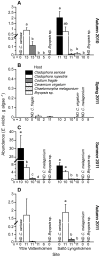Abundance and size distribution of the sacoglossan Elysia viridis on co-occurring algal hosts on the Swedish west coast
- PMID: 24647524
- PMCID: PMC3960251
- DOI: 10.1371/journal.pone.0092472
Abundance and size distribution of the sacoglossan Elysia viridis on co-occurring algal hosts on the Swedish west coast
Abstract
Sacoglossans are specialized marine herbivores that tend to have a close evolutionary relationship with their macroalgal hosts, but the widely distributed species Elysia viridis can associate with several algal species. However, most previous investigations on the field abundance and size distribution of E. viridis have focussed on Codium spp. in the British Isles, and algae from this genus are considered superior hosts for E. viridis. In the present study, we investigated the abundance and size distribution of E. viridis on 6 potential host algae with differing morphologies (the septate species Cladophora sericea, Cladophora rupestris, Chaetomorpha melagonium, and Ceramium virgatum, as well as the siphonaceous species Codium fragile and Bryopsis sp.) at 2 sites on the Swedish west coast over the course of a year. In spring, slugs were almost absent from all algal hosts. In summer and autumn, E. viridis consistently occurred on several of the algal species at both sites. The highest number of small E. viridis were found on C. sericea, intermediate numbers of significantly larger E. viridis were found on C. rupestris, while fewer, intermediate sized animals were found on C. fragile. Throughout the study period, only a few E. viridis individuals were found on C. melagonium, Bryopsis sp., and C. virgatum. Our results indicate that E. viridis is an annual species in Sweden, capable of exploiting co-occurring congeneric and intergeneric algal hosts with differing morphologies. These results corroborate previous findings that E. viridis can exploit several different algal species, but does not indicate that C. fragile is a superior host.
Conflict of interest statement
Figures



Similar articles
-
Individual specialization to non-optimal hosts in a polyphagous marine invertebrate herbivore.PLoS One. 2014 Aug 4;9(8):e102752. doi: 10.1371/journal.pone.0102752. eCollection 2014. PLoS One. 2014. PMID: 25090601 Free PMC article.
-
Food shaped photosynthesis: Photophysiology of the sea slug Elysia viridis fed with two alternative chloroplast donors.Open Res Eur. 2024 Mar 13;3:107. doi: 10.12688/openreseurope.16162.2. eCollection 2023. Open Res Eur. 2024. PMID: 38725452 Free PMC article.
-
Acquired phototrophy through retention of functional chloroplasts increases growth efficiency of the sea slug Elysia viridis.PLoS One. 2015 Apr 1;10(4):e0120874. doi: 10.1371/journal.pone.0120874. eCollection 2015. PLoS One. 2015. PMID: 25830355 Free PMC article.
-
Crawling leaves: photosynthesis in sacoglossan sea slugs.J Exp Bot. 2013 Oct;64(13):3999-4009. doi: 10.1093/jxb/ert197. Epub 2013 Jul 11. J Exp Bot. 2013. PMID: 23846876 Review.
-
Poecilogony and population genetic structure in Elysia pusilla (Heterobranchia: Sacoglossa), and reproductive data for five sacoglossans that express dimorphisms in larval development.Integr Comp Biol. 2012 Jul;52(1):138-50. doi: 10.1093/icb/ics077. Epub 2012 Jun 1. Integr Comp Biol. 2012. PMID: 22659202 Review.
Cited by
-
Individual specialization to non-optimal hosts in a polyphagous marine invertebrate herbivore.PLoS One. 2014 Aug 4;9(8):e102752. doi: 10.1371/journal.pone.0102752. eCollection 2014. PLoS One. 2014. PMID: 25090601 Free PMC article.
-
Food shaped photosynthesis: Photophysiology of the sea slug Elysia viridis fed with two alternative chloroplast donors.Open Res Eur. 2024 Mar 13;3:107. doi: 10.12688/openreseurope.16162.2. eCollection 2023. Open Res Eur. 2024. PMID: 38725452 Free PMC article.
-
Kleptoplasty: Getting away with stolen chloroplasts.PLoS Biol. 2022 Nov 8;20(11):e3001857. doi: 10.1371/journal.pbio.3001857. eCollection 2022 Nov. PLoS Biol. 2022. PMID: 36346789 Free PMC article.
-
Acquired phototrophy through retention of functional chloroplasts increases growth efficiency of the sea slug Elysia viridis.PLoS One. 2015 Apr 1;10(4):e0120874. doi: 10.1371/journal.pone.0120874. eCollection 2015. PLoS One. 2015. PMID: 25830355 Free PMC article.
-
Habitat shapes the lipidome of the tropical photosynthetic sea slug Elysia crispata.Mar Life Sci Technol. 2025 Apr 7;7(2):382-396. doi: 10.1007/s42995-025-00281-1. eCollection 2025 May. Mar Life Sci Technol. 2025. PMID: 40417258 Free PMC article.
References
-
- Krug P (2011) Patterns of speciation in marine gastropods: a review of phylogenetic evidence for localized radiations in the sea. Am Malacol Bull 29: 169–186.
-
- Jensen KR (1997) Evolution of the Sacoglossa (Mollusca, Opisthobranchia) and the ecological associations with their food plants. Evol Ecol 11: 301–335.
-
- Marín A, Ros JD (2004) Chemical defenses in sacoglossan opisthobranchs: taxonomic trends and evolutive implications. Sci Mar 68: 227–241.
-
- Pierce SK, Curtis NE (2012) Cell biology of the chloroplast symbiosis in sacoglossan sea slugs. Int Rev Cell Mol Biol 293: 123–148. - PubMed
-
- Clark KB, DeFreese D (1987) Population ecology of Caribbean Ascoglossa (Mollusca, Opisthobranchia) a study of specialized algal herbivores. Am Malacol Bull 5: 259–280.
Publication types
MeSH terms
LinkOut - more resources
Full Text Sources
Other Literature Sources
Miscellaneous

